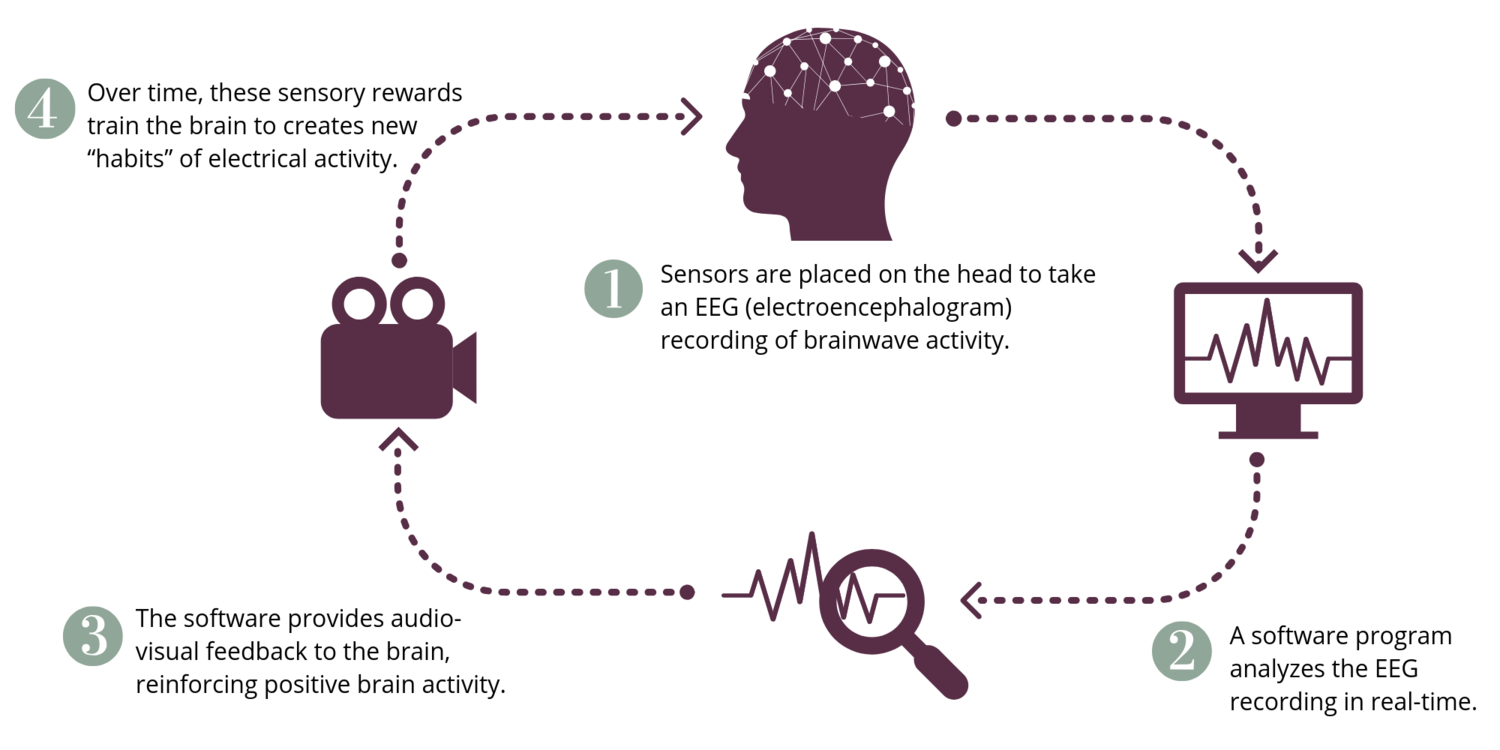Neurofeedback
WHAT IS NEUROFEEDBACK THERAPY?
Neurofeedback is a non-invasive, evidence-based treatment that can encourage healthier brain function through brainwave training.
Our brain cells communicate through electrical impulses, also known as brainwaves.
Normal brainwave patterns can be disrupted by trauma, resulting in patients getting stuck in unhealthy patterns of biological activity and behavior.
Neurofeedback can help the brain become more flexible and develop healthier patterns and responses, a process known as neuroplasticity.
At NWA Premier Therapy we have trained therapists and technicians to provide the interventions to increase your brains flexibility.
The ongoing changing nature of our brain is called neuroplasticity.
How Does Neurofeedback Work?

When a patient’s brainwave activity moves into a healthier state, the brain is rewarded with pleasant video and audio. Our brains, just like animals, are constantly seeking rewards. During a single neurofeedback session, the brain is given multiple opportunities to self-correct and be rewarded.
Highly researched, clinical studies show neurofeedback is
- evidence-based
- safe & non-invasive method to achieve positive outcomes.
Neurofeedback looks for the cause, such as what specific pathways are dysregulated, as well as over or under activated.
Neurofeedback is a process that uses high tech equipment and software to record and address the cause of symptoms within the brain.
The human brain is self-regulating and has a capacity to modify its patterns. During neurofeedback training the brains’ wave patterns are projected onto a screen, mapped and interpreted.
By giving feedback about specific brain waves more harmonious patterns can be increased and dysregulated patterns can be reduced: the brain waves can be increased or decreased to work more harmoniously together to provide a regulated response.
How Can Neurofeedback Help My Issues or Symptoms?
Issues such as anxiety, depression, ADHD, PTSD, sleep problems, memory and concentration problems are a result of dysregulation in the brain.
Neurofeedback is able to assess, as mentioned above, the functioning of the brain and improve areas where it is not functioning properly.
It can locate a specific pattern of neuronal dysregulation, as seen in a concussion and PTSD. Using specific training perimeters dysregulation decreases and brain patterns stabilize.
Neurofeedback Resources:
Does Neurofeedback Work With Trauma?
The goal of trauma-focused neurofeedback is to help shift people from a hyper-aroused state to a calmer one so that they can experience a sense of safety and react more appropriately to everyday events.
There have been many studies showing that neurofeedback can help with symptoms of PTSD. Some have even shown that neurofeedback can change brain function of PTSD patients on imaging or fMRI.
Furthermore, the level of symptom improvement in most of these studies has been significant. In fact, the effect size with neurofeedback in many studies has been greater than any medication used for PTSD.
Combining PBM with Neurofeedback
Neurofeedback is brain wave training, and by combining it with light therapy, we are helping boost the brain’s energy supply to learn and build new connections. In this way, photobiomodulation has a synergetic effect with neurofeedback.
Helping brains develop new connections which support better function is an important part of neurofeedback training. Based on emerging research, tPBM can potentially support the growth of those new pathways.
Penijean Gracefire, LMHC, BCN, qEEG-D
Research Shows That Additional Resources Can Increase Efficacy Of Talk Therapy
Talk therapy for trauma can be helpful in many ways, including:
Validating emotions and helping patients realize that they are not to blame for what happened
Looking at the traumatic event through a new lens
Providing a sense of community, care, and support
However, trauma is stored in deeper parts of the brain and nervous system as whole-body experiences, not just linear narratives. This means that patients don’t just remember what happened as a coherent story – they also remember how they felt and how their bodies reacted. They remember how scared they were, as well as their racing heart and difficulty breathing.
Talk therapy often cannot address these emotional and physical memories of trauma that have become ingrained in the body’s biology.
Additionally, one study found that about 40% of patients in the community with PTSD drop out from CBT (cognitive behavioral therapy), the most recommended type of talk therapy for trauma. Patients need a more comprehensive type of treatment with better outcomes.
Other Resources
For those of you who like to know specific details about the topic of neurofeedback, there are many books on the subject — some are very detailed while others only touch the surface.
- Neurofeedback In The Treatment Of Developmental Trauma; Calming The Fear Driven Brain, by Sebern Fisher
- Getting Started with Neurofeedback, by John Demos
- Biofeedback for the Brain, by Paul G. Swingle, Ph.D.
- Technical Foundations of Neurofeedback, by Thomas F. Collura
- The Healing Power of Neurofeedback, by Stephan Larsen, Ph. D.
- A Consumers Guide To Understanding QEEG Brain Mapping And Neurofeedback Training, by Robert Longo, MRC, LPC, BCN
- Biofeedback for the Brain, by Paul G. Swingle, Ph.D.
- Technical Foundations of Neurofeedback, by Thomas F. Collura